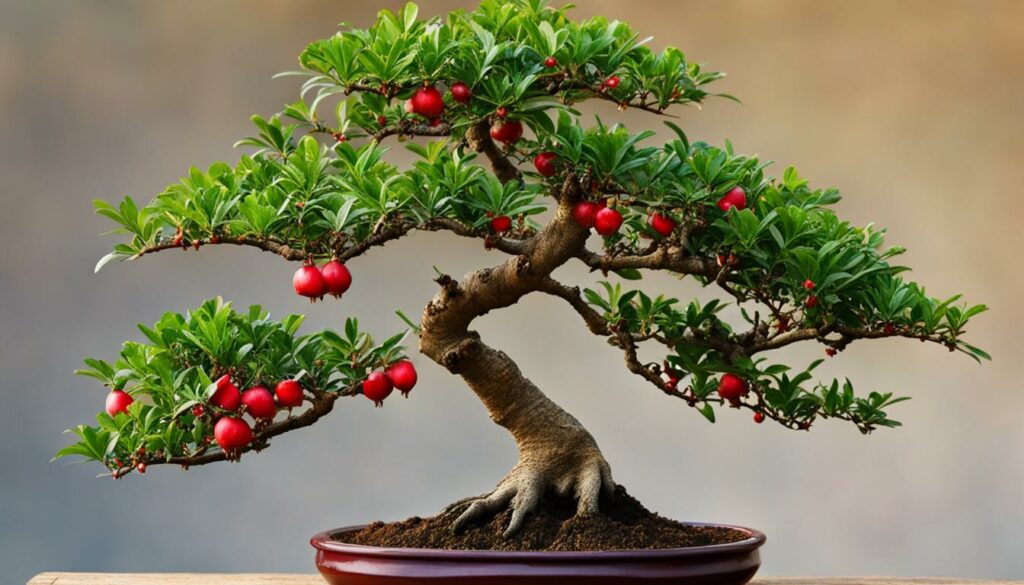If you’re a bonsai enthusiast, you’re probably familiar with the wide variety of bonsai tree species available. One standout option is the Dwarf Pomegranate, a charming and visually stunning choice that offers the added bonus of miniature fruit.
As a bonsai tree species, the Dwarf Pomegranate is a popular choice among enthusiasts. Its compact size and aesthetic appeal make it an excellent choice, while its fruit-bearing capabilities add another layer of attraction.
Key Takeaways
- The Dwarf Pomegranate bonsai tree is an excellent choice for bonsai enthusiasts due to its compact size and ornamental appeal.
- This unique bonsai species is known for its miniature fruit, adding another layer of attraction to its visual appeal.
- Caring for and cultivating Dwarf Pomegranate bonsai trees requires proper techniques and maintenance, including suitable soil conditions, watering requirements, and pruning techniques.
- These enchanting miniature trees can bring beauty and joy into any living space when displayed and cared for properly.
- The Dwarf Pomegranate bonsai tree is a popular choice in bonsai exhibitions and shows, with criteria used to judge the quality of the display.
Introduction to the Dwarf Pomegranate Bonsai Tree
If you love bonsai trees and are looking for a fruiting bonsai that combines ornamental value with the joy of miniature fruits, then the Dwarf Pomegranate bonsai tree might just be the perfect choice for you. As a miniature bonsai, this charming plant is a miniature version of the pomegranate plant but with a compact size ideal for indoor cultivation. What makes Dwarf Pomegranate bonsai stand out among bonsai tree species is its unique ability to bear fruit.
Observe the distinct features and aesthetic appeal of this mini pomegranate tree as a bona fide bonsai species. The Dwarf Pomegranate bonsai boasts an exquisite foliage display, delightful flowers, and a size that is ideal for miniature bonsai enthusiasts. Thanks to its fruiting potential, this pomegranate bonsai is sure to add an extra dash of adventure to your bonsai cultivation experience, and we will detail the growing requirements to help you cultivate this miniature marvel of nature.
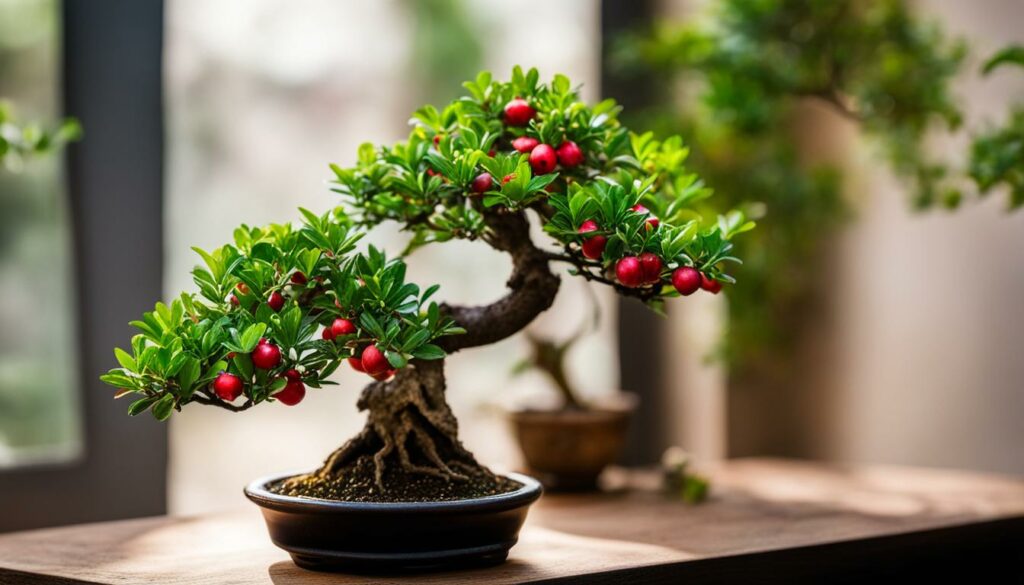
The Dwarf Pomegranate bonsai tree is a detail-oriented miniature bonsai that boasts breathtaking visual display and the ability to bear fruit. If you’re looking for a unique and rewarding bonsai tree species, the Dwarf Pomegranate bonsai is definitely worth delving into.
Origin and History of the Dwarf Pomegranate Bonsai Tree
The Dwarf Pomegranate bonsai tree species has a rich history and cultural significance in different parts of the world. It is believed to have originated in the Mediterranean region, where it was cultivated for its edible fruit and ornamental value.
This miniature bonsai tree became popular among bonsai enthusiasts due to its compact size, ornamental flowers, and potential for fruiting. In Japan, the Dwarf Pomegranate bonsai tree is known as “Kakushi-boke,” which translates to “hidden beauty,” emphasizing the charm of the small but captivating plant.
The Dwarf Pomegranate bonsai tree has also been associated with traditional cultural and religious beliefs. In Ancient Greece, pomegranates were believed to symbolize fertility and prosperity, and were often featured in artwork and mythology. In Hinduism, pomegranates are associated with the goddess of fertility and are offered in ritual ceremonies.
Over time, Dwarf Pomegranate bonsai trees have achieved global recognition and admiration for their beauty and symbolism, becoming a popular addition to bonsai collections around the world.
Characteristics and Appearance of the Dwarf Pomegranate Bonsai Tree
The Dwarf Pomegranate bonsai tree is known for its unique characteristics and visual appeal, making it a highly desirable species for bonsai enthusiasts. The tree itself has a compact size, making it perfect for indoor spaces, while still producing beautiful flowers and miniature fruits.
One of the main attractions of the Dwarf Pomegranate bonsai tree is its stunning flowers, which bloom in shades of orange and red. These delicate flowers are accentuated by the tree’s shiny, dark green leaves, making for a striking overall appearance.
Additionally, the Dwarf Pomegranate bonsai tree produces small, but edible fruit. These fruits are a deep red color and are about the size of a cherry tomato. They are packed with tangy-sweet flavor and are an ideal complement to savory dishes or a sweet snack.
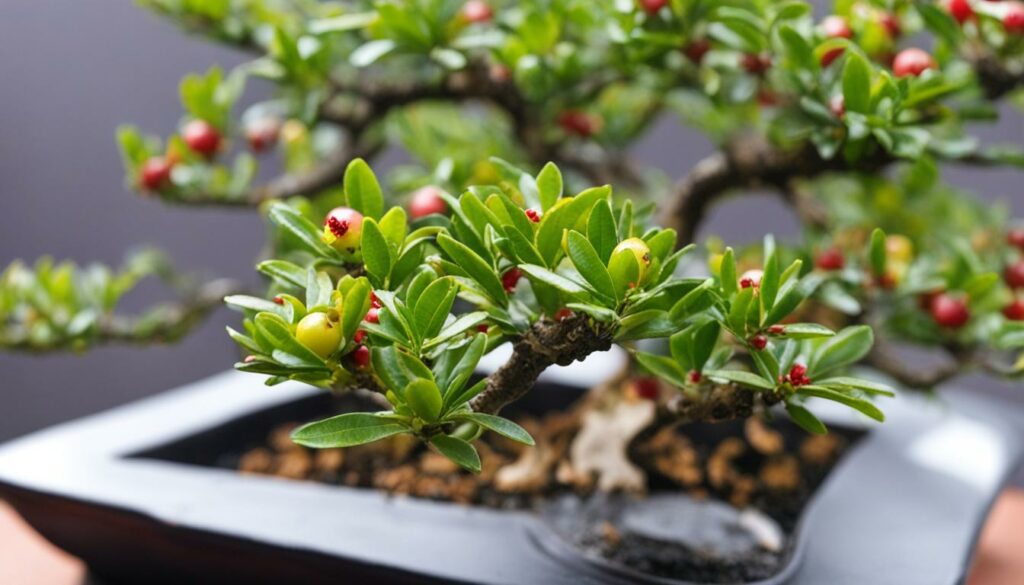
In terms of care, the Dwarf Pomegranate bonsai tree requires regular pruning to maintain its shape and a well-draining soil mix to prevent root rot. It prefers bright, direct sunlight, but it also tolerates partial shade. Watering should be done when the soil is almost dry to the touch.
Overall, the Dwarf Pomegranate bonsai tree is an elegant and charming species that offers both decorative and culinary benefits that make it a beloved choice among bonsai enthusiasts.
Cultivating and Caring for Dwarf Pomegranate Bonsai Trees
Creating and maintaining a healthy Dwarf Pomegranate bonsai tree requires careful attention and dedicated effort. Follow these essential techniques and tips to cultivate a thriving miniature tree:
1. Soil Conditions
Use a well-draining soil mixture that provides adequate moisture and nutrients for your Dwarf Pomegranate bonsai tree. Mix perlite, vermiculite, and sand with potting soil to help with drainage and aeration.
2. Watering Requirements
Water your bonsai tree regularly, but avoid overwatering it. Check the soil frequently to determine when it requires watering, then water thoroughly until the water drains from the bottom of the pot.
3. Pruning Technique
Prune your Dwarf Pomegranate bonsai tree regularly to maintain its shape and promote healthy growth. Use sharp, clean shears to cut away any dead or diseased branches, and trim back any overgrown branches that detract from the tree’s aesthetic appeal.
4. Ideal Growing Environment
Provide your Dwarf Pomegranate bonsai tree with an environment that suits its needs. It prefers a warm, sunny spot that receives at least six hours of sunlight daily. However, it is crucial to protect it from harsh, direct sunlight, as this can damage the tree’s foliage.
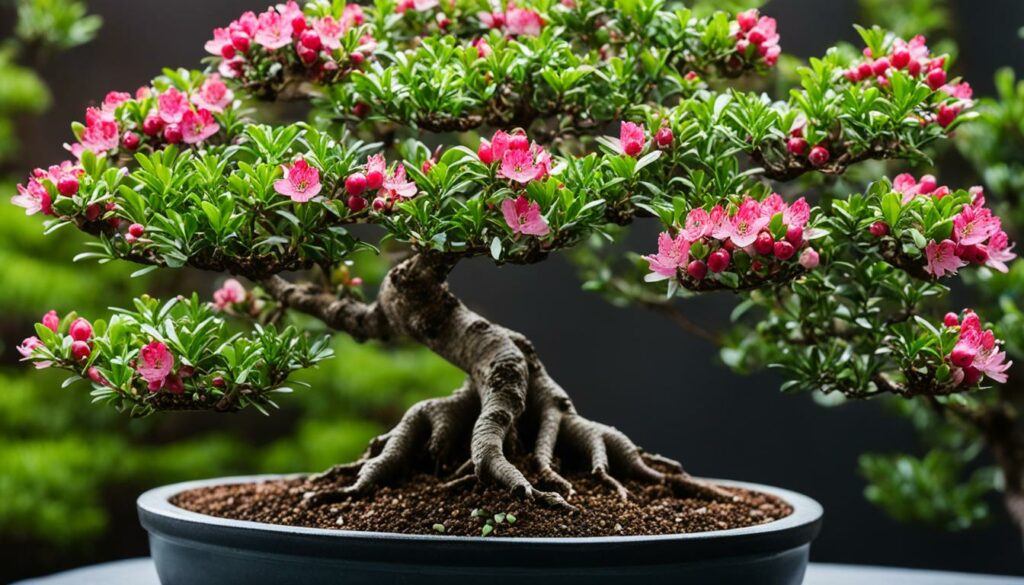
By following these tips, you can be well on your way to growing a thriving and beautiful Dwarf Pomegranate bonsai tree.
Training and Shaping Techniques for Dwarf Pomegranate Bonsai Trees
Creating a visually appealing Dwarf Pomegranate bonsai takes skill and patience. You can learn many techniques such as wiring, pruning, and leaf trimming to shape your bonsai according to your desired form and style.
Here are some techniques for you to practice:
- Wiring: You can use wire to bend branches and direct growth. Wrap the wire around the branch, starting from the base and winding towards the tip, making sure not to leave any gaps.
- Pruning: Pruning helps to shape your bonsai’s growth. Cut back any branches you don’t want to keep or that don’t fit the design of your bonsai.
- Leaf trimming: This technique is used to reduce leaf size and maintain the overall shape of your bonsai. Carefully remove leaves that are too large or detract from the overall design.
Remember to be gentle and patient when shaping your Dwarf Pomegranate bonsai. It can take years to achieve the desired look, but the end result is worth it.
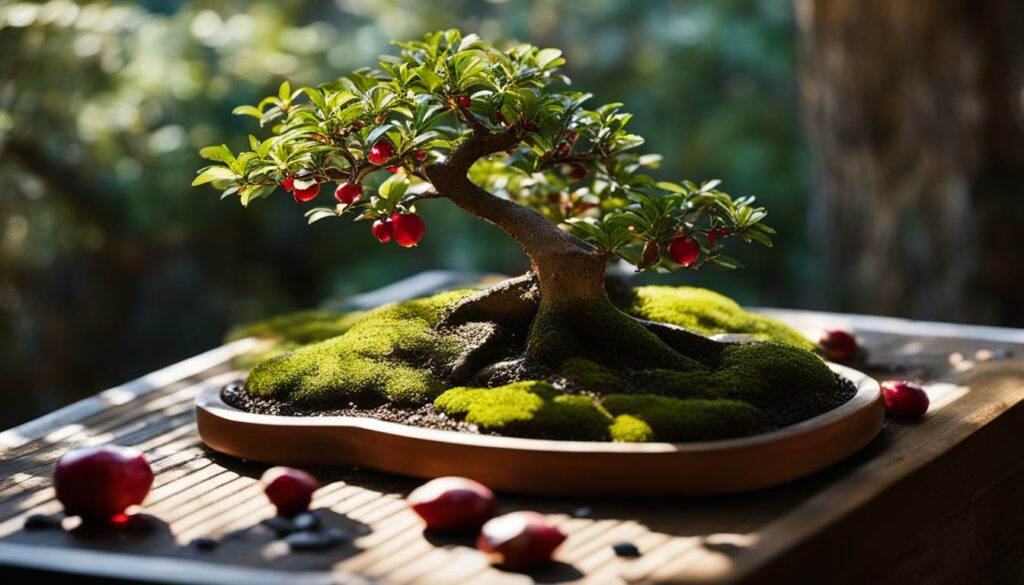
Fruiting Potential of Dwarf Pomegranate Bonsai Trees
The Dwarf Pomegranate bonsai tree is not only aesthetically pleasing but also has the potential to bear small, edible pomegranates. These miniature fruits are a delightful feature that will make your bonsai tree stand out. To ensure fruit production, there are several factors to consider:
- Age: Dwarf Pomegranate bonsai trees should be at least three years old before they can produce fruit.
- Light: These trees require plenty of direct sunlight to produce fruit. If grown indoors, they should receive at least four hours of sunlight each day.
- Watering: Overwatering or underwatering can inhibit fruit production. It’s essential to maintain a consistent watering schedule that keeps the soil moist but not waterlogged.
- Fertilizer: Using the appropriate fertilizer, such as a balanced liquid fertilizer, can help encourage fruit production.
If you are lucky enough to have a fruiting Dwarf Pomegranate bonsai tree, it’s crucial to handle the fruits carefully. They are small and delicate, so pick them gently and avoid crushing or bruising them. You can enjoy the fruits as a snack or use them for cooking, such as in sauces or dressings.
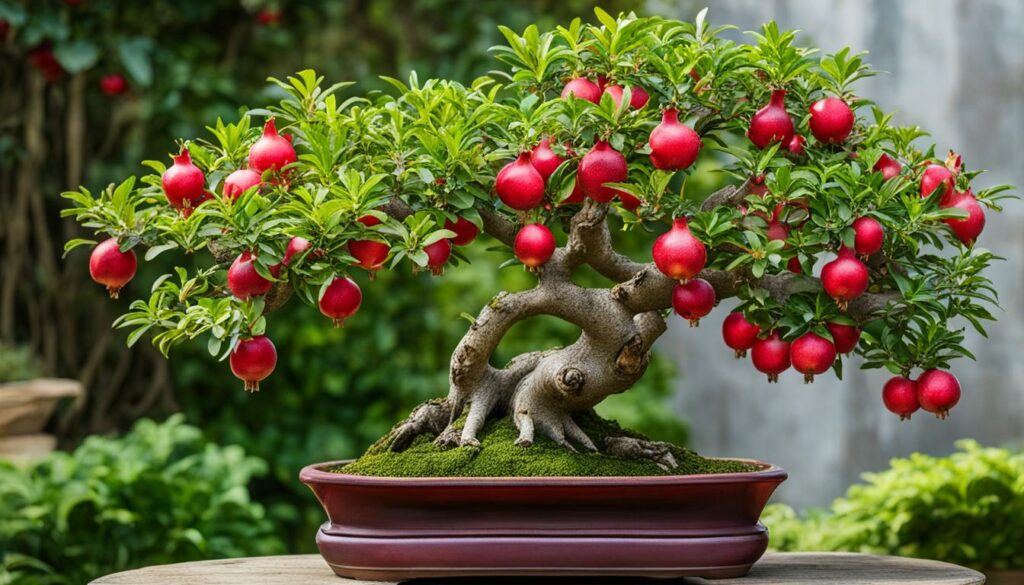
With the right care and attention, your Dwarf Pomegranate bonsai tree can bear fruit and provide a unique touch of beauty and flavor to your home.
Dwarf Pomegranate Bonsai Trees in Bonsai Exhibitions
The popularity of Dwarf Pomegranate bonsai trees in bonsai exhibitions and shows is a testament to their charm and appeal as miniature trees. These captivating plants feature prominently in exhibitions, where they are judged against criteria such as trunk thickness, height, and styling techniques. Bonsai enthusiasts strive to showcase the unique beauty and character of each Dwarf Pomegranate bonsai tree in their display, highlighting the distinctive qualities that make them such an exceptional species.
Admire the stunning displays that showcase the elegance of Dwarf Pomegranate bonsai trees and become inspired to explore the world of miniature bonsai cultivation.
Buying and Maintaining Dwarf Pomegranate Bonsai Trees
As a bonsai enthusiast, you may wonder where to buy Dwarf Pomegranate bonsai trees. Look for reputable nurseries or bonsai specialty stores that offer a variety of bonsai tree species, including the Dwarf Pomegranate. You can also purchase them online from reputable sellers or online bonsai stores.
When selecting a Dwarf Pomegranate bonsai tree, consider its size, age, and overall appearance. Look for a tree with a healthy trunk and branches and vibrant foliage. Avoid trees with signs of damage or disease.
Proper maintenance is crucial for the longevity and health of your Dwarf Pomegranate bonsai tree. Repot your tree every two years to maintain proper soil conditions and ensure adequate root growth. Fertilize your tree regularly with a balanced fertilizer during the growing season and reduce fertilization during the dormant season.
Protect your Dwarf Pomegranate bonsai tree from pests and diseases by regularly inspecting the plant for any signs of infestation or illness. Prune your tree annually to maintain its desired shape and style.
Table: Tips for Maintaining Dwarf Pomegranate Bonsai Trees
| Maintenance Task | Frequency | Additional Info |
|---|---|---|
| Repotting | Every two years | Use well-draining soil and a suitable container size. |
| Fertilizing | During growing season | Use a balanced fertilizer and reduce fertilization during dormant season |
| Pest and Disease Control | Regularly | Inspect for signs of damage or illness and take appropriate action |
| Pruning | Annually | Trim excess growth and shape to desired style |
By buying and maintaining your Dwarf Pomegranate bonsai tree following these tips, you can enjoy its beauty and unique fruiting capabilities for many years.
Enjoying the Beauty of Dwarf Pomegranate Bonsai Trees in Your Home
Having a Dwarf Pomegranate bonsai tree in your home is a great way to add a touch of natural beauty to your living space. These miniature bonsai trees are easy to care for and can thrive indoors if provided with the right growing conditions.
One way to display your Dwarf Pomegranate bonsai tree is to place it on a pedestal or a table where it can be viewed as a centerpiece. You can also create a mini bonsai display by grouping several Dwarf Pomegranate bonsai trees of different sizes and styles together.
To care for your Dwarf Pomegranate bonsai tree, you should ensure it receives adequate sunlight and water. These bonsai trees require regular watering, usually once a week, and should be kept in a location where they can receive natural light for several hours a day.
With proper care, your Dwarf Pomegranate bonsai tree can live for several years, growing and changing with your home’s décor. It’s a unique and captivating way to enjoy the beauty of the natural world right in your own home.
Conclusion: The Enchanting World of Dwarf Pomegranate Bonsai Trees
Now that you’ve learned about the unique characteristics and beauty of Dwarf Pomegranate bonsai trees, you can appreciate why they’re a popular choice for bonsai enthusiasts. With their stunning flowers, miniature fruits, and compact size, they make the perfect addition to any home or garden.
Cultivating and caring for these bonsai trees is a rewarding experience that requires patience and dedication. But with the right techniques and environment, your Dwarf Pomegranate bonsai can thrive and bring joy for years to come.
Whether you’re planning to showcase your Dwarf Pomegranate bonsai in an exhibition or simply enjoy its beauty at home, there’s no denying the enchantment and allure of these captivating trees. So why not embrace the art of bonsai cultivation and add a Dwarf Pomegranate bonsai to your collection today?
Thank you for exploring the world of Dwarf Pomegranate bonsai trees with us. We hope you found this article informative and insightful. Remember to always care for your bonsai tree species, especially the charming Dwarf Pomegranate, with love and patience.
FAQ
What is a Dwarf Pomegranate bonsai tree?
A Dwarf Pomegranate bonsai tree is a miniature version of the pomegranate plant. It is a bonsai species that combines ornamental appeal with the joy of miniature fruits.
How big does a Dwarf Pomegranate bonsai tree grow?
A Dwarf Pomegranate bonsai tree typically grows to be around 1 to 2 feet in height, making it perfect for small spaces and indoor cultivation.
Can a Dwarf Pomegranate bonsai tree bear fruit?
Yes, a Dwarf Pomegranate bonsai tree has the potential to bear small pomegranates. However, it requires proper care, including the right growing conditions and attention to pruning and fertilization, to encourage fruit production.
How do I care for a Dwarf Pomegranate bonsai tree?
To care for a Dwarf Pomegranate bonsai tree, make sure it receives adequate sunlight, water it regularly, and use well-draining soil. Pruning and occasional repotting may also be necessary to maintain its shape and health.
What is the ideal growing environment for a Dwarf Pomegranate bonsai tree?
Dwarf Pomegranate bonsai trees thrive in warm and sunny environments. They prefer temperatures between 60-85°F (15-29°C) and appreciate a consistent, moderate level of humidity.
Can I shape a Dwarf Pomegranate bonsai tree into different designs?
Yes, you can shape a Dwarf Pomegranate bonsai tree using techniques like wiring, pruning, and leaf trimming. These methods allow you to create unique and aesthetically pleasing designs, enhancing its overall beauty.
How long does it take for a Dwarf Pomegranate bonsai tree to bear fruit?
The time it takes for a Dwarf Pomegranate bonsai tree to bear fruit can vary. It typically takes a few years of proper care and maintenance before the tree reaches maturity and produces fruit.
Where can I buy a Dwarf Pomegranate bonsai tree?
Dwarf Pomegranate bonsai trees are available at specialized nurseries, online bonsai shops, and even some garden centers. It’s best to research reputable sellers and ensure they provide healthy and well-cared-for trees.
How do I maintain a Dwarf Pomegranate bonsai tree?
To maintain a Dwarf Pomegranate bonsai tree, regular watering, fertilization, and periodic pruning are important. Additionally, protecting the tree from pests and diseases and providing appropriate light conditions are essential for its long-term health.
Can I display my Dwarf Pomegranate bonsai tree indoors?
Yes, Dwarf Pomegranate bonsai trees can be displayed indoors. However, they still require sufficient sunlight and proper care to thrive. Placing them near a bright window or using grow lights can help meet their light requirements.
Are Dwarf Pomegranate bonsai trees suitable for bonsai exhibitions?
Yes, Dwarf Pomegranate bonsai trees are often featured in bonsai exhibitions and shows. Their unique characteristics, including their small size and miniature fruit, make them captivating specimens that delight bonsai enthusiasts.
